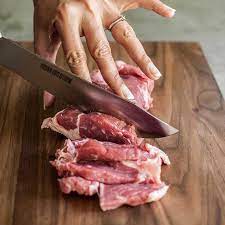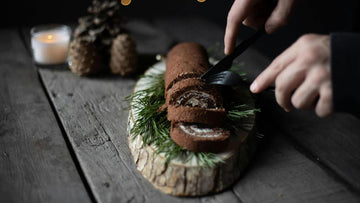Expert Advice on Choosing the Ideal Wood for Your Cutting Board.
by Jerry Barker on Dec 21, 2023

When it comes to picking the wood for your cutting board there are some important factors to keep in mind. Consider the type of wood, its hardness, grain pattern, maintenance requirements and sustainability impact in order to determine which material is most suitable for your kitchen prep surface.
Taking the time to familiarize yourself with the advantages and disadvantages of wood species will ensure that you end up with a cutting board that's long lasting, hygienic, environmentally conscious and visually appealing.
Thing to Consider When Choosing Wood for a Cutting Board:
When deciding which wood species to select for a new cutting board, start by thinking about the following factors:
Hardness Level:
The hardness, or density, of the wood impacts how resistant it is to knife marks, scratches and general wear-and-tear from repeated use.
Harder woods stand up well over time. Common hardwoods used for cutting boards include maple, walnut, cherry and teak. Avoid softwoods like pine which can show deterioration relatively quickly.
Grain Pattern:
The grain pattern relates to the alignment and size of the wood cells. A tight, even grain without a lot of variation between lighter and darker regions tends to be the most durable for a cutting board. The grain pattern can also impact the overall aesthetics and style of the board.
Stain and Moisture Resistance:
Consider woods that have a natural resistance to moisture absorption and potential staining from foods. For example, teak's high oil content makes it very moisture resistant. Meanwhile, walnut contain tannins that tend to resist stains.
Sanding and Finish Needs:
When sanding and finishing a cutting board, it's important to allow the wood to fully cure and avoid any sealants or finishes that could harbor bacteria over time.
Some wood species like teak have higher oil content and may not need finishing treatment.
Hardwood vs Softwood: Which is Better for a Cutting Board?
When deciding whether to choose a hardwood or softwood when making a cutting board, hardwoods are generally superior in terms of durability, longevity and appearance over time. Here’s an overview of their relative pros and cons:
Hardwoods:
- More dense, harder surface resists cuts and indentations
- Attractive grain patterns like maple and walnut
- Withstands frequent use for longer period
- Doesn’t easily harbour bacteria
- More expensive and takes longer to source responsibly
Softwoods:
- Very inexpensive and widely available
- Prone to showing knife marks and damage
- Can warp or crack over time
- Not as smooth of a cutting surface/experience
- Difficult to properly sanitize with lots of crevices
While a softwood cutting board may seem appealing as an affordable option, it will likely need to be replaced much sooner and isn’t the best for food preparation when compared next to a hardwood board.
Spending a bit more upfront on a durable hardwood board is worthwhile.
Popular Types of Hardwoods for Cutting Boards:
While there are lots of dense hardwood species to choose from, the following are some of the most popular and recommended for cutting boards that balance performance, maintenance needs, cost and visual appeal:
Cherry:
Moderately dense hardwood. Lovely reddish, warm toning. Stains well for unique patterns. Prone to some moisture absorption without finish. Dents less severely than softer woods.
● Care tips:
- Allow long cure time for finishes to set properly
- Use lemon/salt scrub to brighten from stains
- Apply mineral oil more frequently than other woods
Maple:
Maple are Extremely hard, dense wood that withstands daily wear-and-tear. Has light colouring that makes it easy to see cut marks for cleaning. Fairly moisture-resistant. An all-around excellent choice.
● Care tips:
- Wash with hot soapy water after each use
- Dry completely upside down to prevent moisture absorption
- Apply food-grade mineral oil every 1-2 months for protection
Teak:
Teak has very high oil content for water resistance. No need to apply a finishing treatment. Extremely dense grain and naturally scratch-resistant surface. More expensive, but long-lasting.
● Care tips:
- Wash with diluted bleach solution to inhibit bacteria
- Air dry thoroughly as moisture can warp surface
- High oil content means no oil treatments needed
Oak:
Oak delivers a rich, dark wood grain aesthetic. Naturally antibacterial properties. Accents lighter foods nicely. High oil content minimizes moisture. Durable for frequent kitchen use.
● Care tips:
- Hand Wash to prevent cracking/splitting from hot temps
- Pat dry with a towel instead of air drying
- Treat with beeswax or mineral oil seasonally
Bamboo:
Bamboo is an Eco-friendly, sustainable option as bamboo grasses grow rapidly. Extremely durable and hard surface. Natural antimicrobial qualities. Contemporary appearance. Prone to some surface splitting over time.
● Care tips:
- Soak in a 50/50 water/vinegar solution to clean
- Use coconut oil to revive dried-out surfaces
- Sand down to refresh knife-worn outer veneer
No matter which you choose, be sure to follow proper maintenance like immediately drying after washing and reapplying food-safe mineral oil periodically to keep the wood from drying out.
Combine this care with a durable hardwood, and your cutting board can serve as a lifetime kitchen prep surface.
Sustainability and Environmental Impact of Wood Choices:
There are a wide range of dens tropical and domestic hardwood species available—but not all types of wood are equal when it comes to sustainable harvesting and responsible sourcing.
Being an informed consumer and selecting woods certified to come from managed forests helps protect the future of the world’s timber resources.
Buy Locally-Grown Domestic Hardwoods:
Choosing woods sourced regionally from North American forests (like maple, walnut, cherry, oak, etc) supports local economies, minimizes transportation emissions, and are subject to regulated forestry standards.
Look for FSC Certification:
The Forest Stewardship Council (FSC) certifies lumber mills and wood sources that utilize responsible harvesting practices to protect biodiversity and water quality, manage tree regrowth, uphold labour standards, and more.
Understand Illegally-Logged Tropical Hardwood Issues:
While exotic hardwoods like teak, rosewood, and ebony can make for beautiful cutting boards, illegally harvested tropical timbers contribute to deforestation, climate change impacts, and more.
Make sure any imported hardwood comes from verified legal and sustainable sources.
Consider Bamboo as a Renewable Option:
Bamboo is an eco-friendly cutting board choice as it rapidly regrows after harvesting, often without pesticides. Confirmed sources use proper management practices for new shoot productivity and ecosystem diversity.
No matter what wood type you select, purchasing from responsible sources helps protect forests and ecosystems for future generations.
Pair this care with proper cutting board maintenance habits, and you’ve got an environmentally-friendly kitchen prep surface perfect for everyday cooking needs.
Safety Precautions When Working with Wood for Cutting Boards:
Creating a cutting board from raw wood requires working with power tools and machinery that can pose injury risks if proper precautions aren’t taken.
Follow these tips for safely working with lumber:
Use Protective Gear:
Wear safety glasses, dust masks, ear protection, gloves and non-slip steel-toe boots when dimensioning, sawing, routing, sanding, and finishing wood. Prevent breathing fine particulates or ear damage from machinery noise.
Operate Tools Properly:
Take training courses if you are unfamiliar with how to correctly and safely operate table saws, band saws, drill presses, routers and other workshop tools to avoid injuries. Refer to device manuals and follow all instructions provided.
Set up a Safe Workspace:
Keep the floor clear of scraps, tools not in use, and other slip/trip hazards. Ensure adequate lighting, ventilation, and machine guards. Position machines stable on level surfaces and secure lumber prior to cutting.
Make Relief Cuts When Sanding:
When using power sanders, make relief cuts across the wood grain instead of over-sanding in the same direction to avoid aggressive material removal leading to weakened board integrity.
Allow Finishes to Cure:
Apply protective oils, waxes and other finishing products in ventilated areas and allow adequate drying time before handling to prevent irritation. Only use food-safe, non-toxic products on cutting boards.
Woodworking offers the supreme satisfaction of creating personalized, useful items for your home. But be sure to prioritize safety—a quality cutting board is never worth injury from improper workshop technique or haste.
Allow plenty of time for the proper methods and materials handling.
FAQs:
What are the differences between end-grain vs edge-grain cutting boards?
End-grain cutting boards are made from blocks of wood glued together with the grain running vertically. This distributes knife cuts between the wood fibers for enhanced durability and self-healing properties.
Edge-grain boards have wood pieces glued with the grain running parallel to the surface, making them slightly less resistant to cuts over time. Both can make excellent cutting boards with proper maintenance.
How thick should a wooden cutting board be?
A general rule of thumb is 1 inch thick or slightly more for hardwood cutting boards. Anything less than 3⁄4 inches can warp more easily.
Extremely thick boards beyond 1.5 inches can be challenging to properly dry and maintain over time.
Select a thickness suited to the types of cooking tasks thinner boards around 1 inch work well for lighter everyday ingredient chopping and serving, while thicker boards can withstand intense butchery work.
Conclusion:
Wooden cutting boards deliver functionality, reliability and aesthetic appeal unmatched by plastic or synthetic versions—but only if the right wood type is selected and properly cared for. Taking into consideration hardness,
moisture-resistance, appearance, cost, sustainability impacts and usage needs allows you to tailor the perfect cutting board for all your food preparation needs.
Combine thoughtful wood choices with vigilant maintenance habits like drying after washing and re-oiling periodically, plus a safety-first approach when fabricating in a woodworking studio, and your new wooden cutting board is sure to serve as a treasured lifetime kitchen staple.



